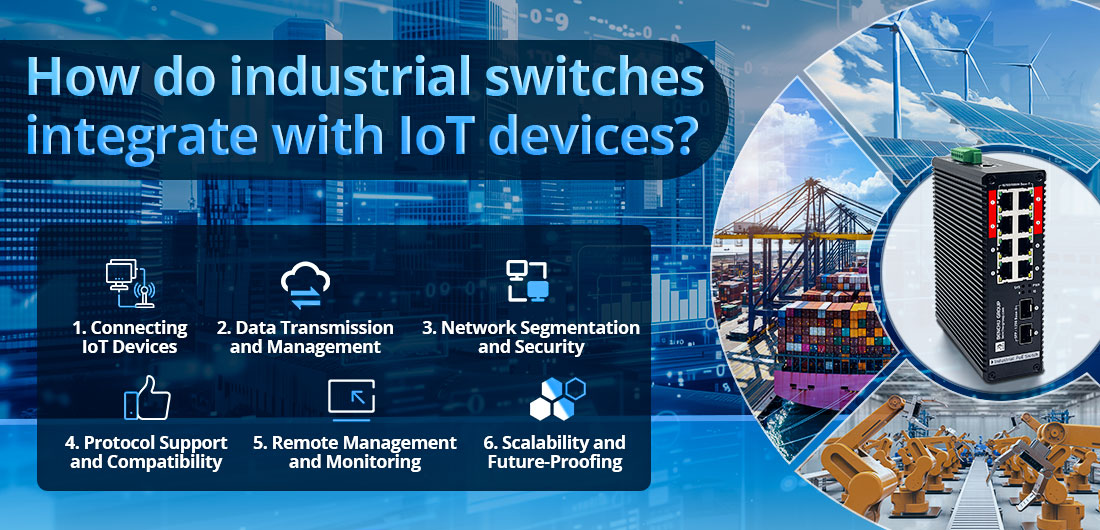
Industrial switches play a crucial role in integrating IoT (Internet of Things) devices within industrial environments, facilitating seamless communication, data management, and network security. Here’s a detailed description of how industrial switches integrate with IoT devices:
1. Connecting IoT Devices
a. Robust Networking Infrastructure
--- Multiple Ports: Industrial switches typically feature multiple Ethernet ports, allowing the connection of numerous IoT devices, such as sensors, actuators, and cameras. This scalability is essential for large industrial setups where many devices need to communicate.
b. Power over Ethernet (PoE) Support
--- Simplified Wiring: Many industrial switches support PoE, enabling IoT devices to receive both power and data through a single Ethernet cable. This simplifies installation, particularly for devices located in hard-to-reach areas without power outlets.
2. Data Transmission and Management
a. High-Speed Data Handling
--- Gigabit Ethernet Support: Industrial switches often support Gigabit Ethernet, which is vital for handling the high data throughput required by IoT devices, especially those that transmit large amounts of data, like video surveillance cameras or advanced sensors.
b. Quality of Service (QoS)
--- Prioritizing IoT Traffic: QoS mechanisms allow for the prioritization of IoT traffic, ensuring that critical data from sensors and control devices is transmitted with minimal latency. This is essential for applications that require real-time responses.
3. Network Segmentation and Security
a. VLAN Support
Isolating IoT Traffic: Industrial switches can create Virtual LANs (VLANs) to segment IoT device traffic from other network traffic. This isolation enhances security by limiting access to sensitive data and reducing the risk of unauthorized access.
b. Access Control Lists (ACLs)
Enhancing Security: ACLs can be configured on industrial switches to control which devices can communicate with each other, protecting the network from potential threats posed by compromised IoT devices.
4. Protocol Support and Compatibility
a. Support for Standard Protocols
Communication Protocols: Industrial switches are compatible with various communication protocols used by IoT devices, such as MQTT, CoAP, and Modbus. This compatibility ensures that devices can communicate effectively within the network.
b. Integration with Edge Computing
Real-Time Processing: Industrial switches can facilitate the integration of edge computing solutions, where data from IoT devices is processed locally. This reduces latency and bandwidth usage, allowing for faster decision-making based on real-time data.
5. Remote Management and Monitoring
a. Web-Based Management Interfaces
--- Ease of Configuration: Many industrial switches come equipped with web-based management interfaces, enabling network administrators to configure settings, monitor traffic, and troubleshoot issues remotely. This capability is especially beneficial in industrial environments where devices are distributed over large areas.
b. Diagnostic Tools
--- Performance Monitoring: Industrial switches often include diagnostic tools that provide real-time statistics on network performance, helping identify issues with IoT device connectivity or performance.
6. Scalability and Future-Proofing
a. Modular Design
--- Adaptable Architecture: Industrial switches can often be expanded or upgraded to accommodate new IoT devices as they are added to the network. This modularity ensures that the network can evolve alongside technological advancements.
b. Integration with Cloud Services
--- Data Analytics and Storage: Many industrial switches can connect IoT devices to cloud services, enabling data analytics, storage, and further integration with other enterprise systems. This enhances the overall functionality and data utilization of IoT applications.
7. Applications in Various Industries
a. Manufacturing Automation
--- Smart Factories: In smart manufacturing environments, industrial switches connect IoT sensors and devices that monitor machine performance, production quality, and operational efficiency, allowing for real-time data analysis and control.
b. Energy Management
--- Smart Grids and Meters: Industrial switches enable communication between IoT devices in smart grids, allowing for real-time monitoring of energy consumption and management of distributed energy resources.
c. Transportation and Logistics
--- Fleet Management: In logistics, industrial switches integrate IoT devices for tracking shipments, monitoring vehicle conditions, and optimizing routes, enhancing operational efficiency and visibility.
8. Conclusion
Industrial switches are vital for integrating IoT devices into industrial networks, providing the necessary connectivity, data management, and security features required for effective operation. Their ability to support multiple protocols, prioritize traffic, and enable remote management makes them essential in modern industrial applications. By facilitating seamless communication between IoT devices, industrial switches help organizations leverage the full potential of IoT technologies, driving efficiency, reliability, and innovation across various sectors.